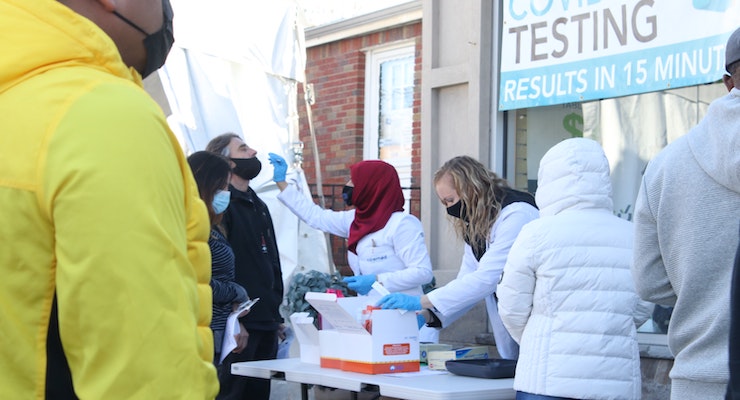When the coronavirus pandemic struck, it created difficulties in all our lives. With millions thrust into unemployment, millions more losing work hours or childcare while facing hospitalization and even death, it has been a challenging time, to say the least.
For immigrant communities—particularly the women within these communities—COVID-19 has struck the hardest. These and other minority demographics have borne a disproportionate share of the burden, and the effects of this inequality will be felt by all.
The revelation of COVID-19’s impact on immigrant communities demonstrates a larger problem. Here, we explore this impact as well as how to best support affected communities.
The Disproportionate Impact of COVID on Immigrants
According to research published on PubMed Central (PMC), there are at least 46.7 million immigrants in the U.S., including 11 million undocumented immigrants. These individuals, families, and communities face greater challenges in light of pandemic difficulties, with diminished access to everything from health insurance to the aid provisions of the Coronavirus Aid, Relief, and Economic Security (CARES) Act. As a result, the dangers of COVID-19 tend to fall harder on immigrant communities.
The consequences of these inequalities may spiral for generations and linger in many sectors of the economy. Here are the details.
Placed at Greater Risk
Immigrants tend to have much higher risk factors across a wide variety of metrics than many native-born individuals. According to a study published by PMC, these risks factors include:
- Statistically, those coming from Central America are at greater risk of obesity and hypertension.
- Mode of entry into the U.S. can signify an increased risk for PTSD, depression, and anxiety.
- Immigrants in regions like Texas are employed most commonly in “essential” industries like construction, food service, and healthcare. This places them at greater risk of exposure.
- Working immigrants are more likely to use public transportation, another high-risk exposure area.
Placed at greater risk, immigrants also stand to suffer most from job loss and income reduction due to illness or shutdowns. In no sectors of the economy is this felt more than in food and agriculture, where immigrants make up the majority of the labor force. As many as 75% of agriculture workers are foreign-born, taking on invaluable jobs like planting, fertilizing, picking, and maintaining livestock. Immigrants who own their own businesses in these sectors also felt the impact.
Illness and job loss among this group of workers have devastating effects on supply chains and all linked consumers. But the economic consequences are even worse for the workers.
Locked out of Federal Relief
Despite the expansion of unemployment insurance and aid provisions to even gig workers and the self-employed, federal relief programs like the CARES Act failed to include immigrants. These often high-risk, highly-essential workers have next to no protection from the economic hazards of the pandemic.
In the distribution of stimulus payments, for example, unauthorized workers were excluded despite them having paid into the unemployment insurance fund. This left an estimated 14.4 million people without assistance, according to the Migration Policy Institute (MPI).
Additionally, the MPI reported that 3.7 million low-income uninsured noncitizens will not have coverage for COVID treatment.
With women overrepresented in highly impacted sectors of the economy and underrepresented in safer areas, the health and financial wellness of female immigrants is at even greater risk than their male counterparts. This places all kinds of families in a disadvantaged position. Add to it school closures in favor of online learning, and we face a crisis in which many children of immigrants cannot access education due to financial barriers.
These barriers can create a chain reaction of lost opportunity and increased poverty that will make itself felt for generations. Fortunately, however, support resources exist for these vulnerable communities.
Help and Support
Whether you are looking for resources for yourself or advocating for another, the search for immigrant resources during the pandemic can be a high-stress and desperate journey. The good news is you are not without aid.
First, the CARES Act did not explicitly exclude immigrants either. Two billion dollars in federal aid was given to community health centers that treat patients regardless of immigration status. Additionally, no immigration status qualifier was added to the expansion of family leave provisions during the pandemic.
While these may be marginal resources for supporting communities in need, plenty more is out there. Entire databases of support resources for immigrants and refugees are available to be taken advantage of. These resources offer all kinds of aid in securing necessities, including:
- Education
- Employment
- Health
- Housing
- Legal
- Safety
Depending on your locale, you may be eligible for additional resources as well. According to the MPI, the state of California has allotted $75 million in cash assistance for immigrants, with other states and philanthropic organizations following suit.
Immigrants and advocates alike can search these resources for the help they need. Additional grants, support, training, and advice are available from employment to thriving as a woman in a male-dominated career.
Until the needs of immigrants are addressed at a broader level, these support resources are here in an attempt to mitigate the worst of the impact of COVID-19 on immigrant communities. If this impact continues to go unaddressed, however, millions of families face uncertain futures and fraught economic positions.
Charlie Fletcher is a freelance writer from the lovely “city of trees”- Boise, Idaho. Her love of writing pairs with her passion for social activism and search for the truth. You can see more of her work on Contently.
















